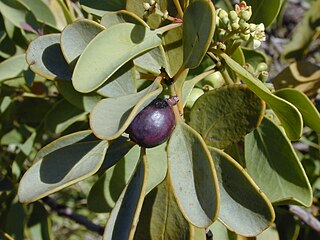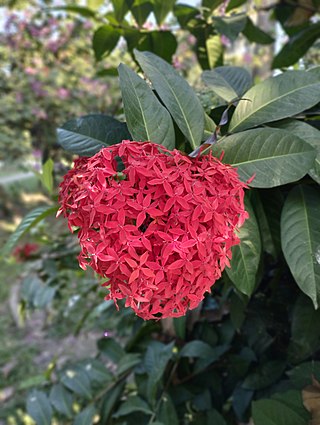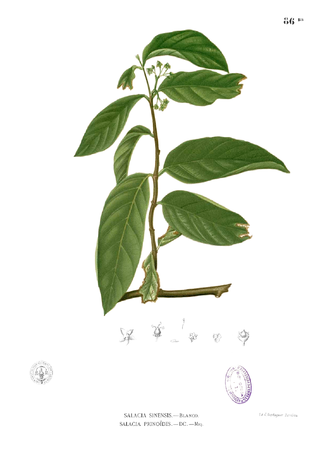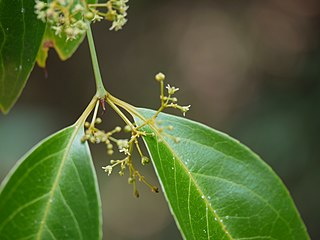
The Santalaceae, sandalwoods, are a widely distributed family of flowering plants which, like other members of Santalales, are partially parasitic on other plants. Its flowers are bisexual or, by abortion, unisexual. Modern treatments of the Santalaceae include the family Viscaceae (mistletoes), previously considered distinct.

The Celastraceae are a family of 98 genera and 1,350 species of herbs, vines, shrubs and small trees, belonging to the order Celastrales. The great majority of the genera are tropical, with only Celastrus, Euonymus and Maytenus widespread in temperate climates, and Parnassia (bog-stars) found in alpine and arctic climates.

Ixora is a genus of flowering plants in the family Rubiaceae. It is the only genus in the tribe Ixoreae. It consists of tropical evergreen trees and shrubs and holds around 544 species. Though native to the tropical and subtropical areas throughout the world, its centre of diversity is in Tropical Asia. Ixora also grows commonly in subtropical climates in the United States, such as Florida where it is commonly known as West Indian jasmine.

Pauridiantha is an afrotropical genus of plant in family Rubiaceae.
Sericanthe is a genus of flowering plants in the family Rubiaceae. It is found in tropical and subtropical Africa. The genus was described by Elmar Robbrecht in 1978 based on the species in Neorosea, except for the type species, Neorosea jasminiflora, which went to Tricalysia. Bacterial leaf nodules are found in most of the species and the endophytic bacteria have been identified as Burkholderia.

Tricalysia is a genus of flowering plants in the family Rubiaceae. The genus is found in tropical and southern Africa and on the islands in the Western Indian Ocean.

Salacia is a genus of plants in the family Celastraceae. They are woody climbers naturally found in tropical regions.

Corynanthe is a genus of flowering plants in the family Rubiaceae.

Heinsia is a small genus of flowering shrubs or small trees in the family Rubiaceae. They are native to tropical Africa. The genus was first formally named in 1830 by Augustin Pyramus de Candolle.
Tristemonanthus is a genus of flowering plants belonging to the family Celastraceae.
Thyrsosalacia is a genus of flowering plants belonging to the family Celastraceae.

Reissantia is a genus of flowering plants belonging to the family Celastraceae.

Loeseneriella is a genus of flowering plants belonging to the family Celastraceae.
Apodostigma pallens is a species of flowering plant belonging to the family Celastraceae. It is a liana native to tropical Africa and Madgascar. It grows from 5 to 15 meters tall, with green to yellow-cream flowers. It is the sole species in genus Apodostigma.

Arnicratea is a genus of flowering plants belonging to the family Celastraceae.
Elachyptera is a genus of flowering plants belonging to the family Celastraceae.
Pristimera is a genus of flowering plants belonging to the family Celastraceae.
Monosalpinx is a genus of flowering plants belonging to the family Rubiaceae.
Simicratea is a monotypic genus of flowering plants belonging to the family Celastraceae. The only species is Simicratea welwitschii.










